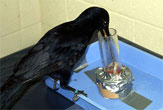
Bird brained they might be, but crows are the MacGyvers of the avian world, able to turn twigs and even their own feathers into tools for getting at hard-to-reach food.
But while young crows are born with a propensity for crafting tools, it's only after watching their elders make and use tools that they become truly proficient, a new study suggests.
Compared to other crows, those from the Pacific island of New Caledonia, located east of Australia, are master tool makers and users, second only to humans and on level with chimps when it comes to finding novel uses for everyday objects. In their natural forest environment, the midnight-black birds fashion twigs [video], leaves and even their own feathers [image] into tools for rooting out insects in dead wood.
The crows craft tools to specific needs [image]. They examine a problem and then pick or design an appropriate tool [video]. For example, faced with a snack lodged in a small tree hole, a crow will prune and adjust a leafy oak branch to just the right width to poke into the hole.
Scientists have found that crows living on different parts of the island display variations in tool shapes, a discovery that suggests young crows learn to fashion tools in a particular way from relatives and other crows living nearby. If so, it would mean the birds possess a culture of tool technology on par with that of humans.
To test this idea, researchers at the University of Oxford in the U.K. hand-raised [image] four Caledonian crows— two received lessons [video] in tool use from human foster parents, while the other two did not. Despite their different upbringings, all four juvenile birds used sticks to retrieve food from crevices, proving that crows have an innate ability for tool use.
However, Uek and Nalik, the two birds schooled in tool-making, carried and inserted twigs into crevices faster and more often than Oiseau and Corbeau, the two naïve crows. Also consistent with the idea that tool use among crows is partly inherited and partly learned, the researchers found that tools made by the four captive crows were crude compared with those made by adult crows living in the wild.
Sign up for the Live Science daily newsletter now
Get the world’s most fascinating discoveries delivered straight to your inbox.
The researchers suggest that insights gained from studying crows could be applied to humans to help reveal how tool use evolved in our own species. Experiments can be performed with crows that are not practical with human children, and birds develop faster than chimps.
The study, conducted by Ben Kenward, Christian Rutz, Alex Weir and Alex Kacelnik, will be detailed in an upcoming issue of the journal Animal Behavior.
- In the Tool Shed, Apes Plan Ahead
- Gorillas Photographed Using Tools
- Avian Ancestors: Dinosaurs that Learned to Fly
- Birds of Prey: Spot Today's Dinosaurs










